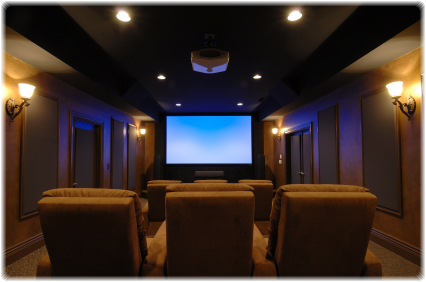


Picture Perfect
by
Patty Wagner
One of the most exciting developments in home entertainment has been the flat screen TV. The concept has been around for decades, particularly in the form of thin screens and expensive forward projectors; but only lately has the technology been offered at prices that average middle class Americans can afford. With the current economic downturn, more and more Americans are seeking simple, homey comforts; trading in extravagant vacations for the new "stay-cation." Thus, home theaters are becoming standard in many homes, whether in a designated theater room, or simply a modified living room.
Although the cost is now affordable, a new flat screen TV is still a considerable investment. New owners want to be sure they optimize their viewing experience. Therefore, they are seeking some rules-of-thumb. How far should one sit back from the screen, given its size? How high should the screen be mounted on the wall for ultimate viewing?
Hanging Height at eye level
The ideal height to hang or set your screen is at eye-level when in the viewing position. The Society of Motion Pictures and Television Engineers (SMPT) has recommended that the screen width occupy a 30 degree field of vision with the horizontal plane when you are seated. Imagining your are looking downwards from the ceiling, it would look like this:
Assuming you are seated at the center of the screen, the angle, a, would ideally be 30°. Since you are seated at a point perpendicular to the midpoint of your screen, we can write:
tan 15° = w/2d → .27 = w/2d → d = 1.9w
Since nearly all flat screen TVs have a 16:9 ratio, we can show that
height = (9/16)w
screen size (diagonal) = √ (w2 + (9/16)w2) → size = (4/5)w
Thus, the ideal viewing distance is (1.9)(4/5)size = 1.5 times the size of your flat screen TV.
Of course, owners are placing multiple rows of seating in many of today's home theaters, necessitating a more liberal rule of thumb for seating. In addition, we know that to some extent, seating position is a matter of preference given the variety of preferred seating in a standard movie theater.
THX Certification recommends that the screen width occupy no more than 36° and no less 26° of the field of view along the horizontal plane. In this case,
tan 13° = w/2d = 2s/5d, (where s = size of the TV), d = 1.7s
tan 18° = 2s/5d, d = 1.2s
So the theater seats should be placed no closer than 1.2 times the size of the TV screen and no further than 1.7 times the size of the screen for optimal viewing.
Hanging Height above eye level
Many people object to hanging or standing their flat screen televisions at eye level as they feel it is too easily blocked and/or doesn't look quite right with the room decor. In this case, some other considerations need to be addressed. Obviously, if the screen is mounted above eye level, the front row seats will have the greatest angle from the viewer to the top of the screen. SMPT recommends this angle not exceed 35° since any larger angle will result in neck strain. On the other hand, studies have shown that if the screen occupies less than 15° in the viewers vertical field of vision, the image will appear too small.
The person sitting in the front row in the picture at left will need a vertical angle of less than 35° to the top of the screen and the person in the back row will need a vertical field of vision angle greater than 15° for optimal viewing.
tan β = total height/distance → .7 = total height/distance → distance ≥ 1.4 times the total height.
So the front row seats should not be placed any nearer than 1.4 times the distance from the floor to the top of the TV.
The back row seats is a bit more complicated. This is because we are dealing with an angle of vision that depends on the size of the screen as a separate factor from the height.
If we assign a value, say γ, to the angle under α, we can say
tan λ = h/d where h = height and d = distance.
tan (α + γ) = (s + h)/d where s is the height of your TV.
Since tan(α + γ) = (tanα + tanγ)/(1-tanαtanγ), we have tanα + h/d = (h + s)/d (1 - (h/d)tanα)
tanα = sd/d2 + h2 + hs
Since α needs to be less than or equal to 15°, we get
.27 ≤ sd/d2 + h2 + hs
Obviously, this doesn't result in an easy rule of thumb. We can however, examine the graph of this equation for common TV screen sizes (using approximate height) in order to realize some important rules regarding how high each size TV can be hung and the maximum distance away from the wall the last row should be placed.
Pictured below are the curves obtained if you have a 26", 32" or 37" widescreen television.

The smallest curve, representing a 26" screen, indicates that the maximum height from floor to bottom of the screen should only be about 18". The 37" TV allows a height of 25". The shaded area represents the range of acceptable seating for each value of the hanging height.
For example, if you have a 32" widescreen television and you want to hang it 18" above the ground (measuring from floor to bottom of the screen), an acceptable seating range would be about 18" to about 48" away. Of course, we need to apply our rule of thumb to reduce neck strain, which says we need to sit at least 1.4 times the total height away from the wall. Our total height is 18" plus the height of the TV, which is about 18." This tells us that you would need to sit at least 50" away to reduce neck strain.
Our result from our first rule of thumb says we need to sit at least 50" away, and the second result shows we need to sit closer than 48"! For the best viewing experience, the owner needs to do one of two things: provide reclined seating, which will alleviate neck strain, or lower the hanging height of the television.
Below are the curves generated for televisions that are 40", 42", and 46-47" (blue) and 50-52", and 55" (yellow).
Just as in the previous example, you can see the maximum height that each size TV can be reasonable hung and the acceptable seating range at each height. To determine which curve corresponds to which television size, just remember that the smaller the TV, the smaller the curve.
Return to Patty Wagner's home page